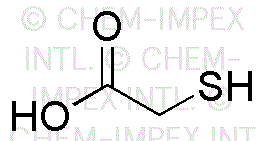Thioglycolic acid is widely utilized in research focused on:
- Cosmetic Formulations: It is commonly used in hair removal products, such as depilatories, due to its ability to break down keratin, making hair easier to remove.
- Textile Industry: This compound serves as a reducing agent in the dyeing process, enhancing the color uptake of fabrics and improving overall dye performance.
- Pharmaceutical Applications: Thioglycolic acid is employed in drug formulations as a stabilizing agent, particularly in the development of topical treatments, enhancing skin penetration and efficacy.
- Metal Surface Treatment: It is used in metal etching and surface cleaning, providing effective removal of oxides and contaminants, which is crucial in manufacturing processes.
- Research and Development: In laboratories, it is utilized for synthesizing various organic compounds, particularly in the field of organic chemistry, due to its reactivity and versatility.
General Information
Properties
Safety and Regulations
Applications
Thioglycolic acid is widely utilized in research focused on:
- Cosmetic Formulations: It is commonly used in hair removal products, such as depilatories, due to its ability to break down keratin, making hair easier to remove.
- Textile Industry: This compound serves as a reducing agent in the dyeing process, enhancing the color uptake of fabrics and improving overall dye performance.
- Pharmaceutical Applications: Thioglycolic acid is employed in drug formulations as a stabilizing agent, particularly in the development of topical treatments, enhancing skin penetration and efficacy.
- Metal Surface Treatment: It is used in metal etching and surface cleaning, providing effective removal of oxides and contaminants, which is crucial in manufacturing processes.
- Research and Development: In laboratories, it is utilized for synthesizing various organic compounds, particularly in the field of organic chemistry, due to its reactivity and versatility.
Documents
Safety Data Sheets (SDS)
The SDS provides comprehensive safety information on handling, storage, and disposal of the product.
Product Specification (PS)
The PS provides a comprehensive breakdown of the product’s properties, including chemical composition, physical state, purity, and storage requirements. It also details acceptable quality ranges and the product's intended applications.
Certificates of Analysis (COA)
Search for Certificates of Analysis (COA) by entering the products Lot Number. Lot and Batch Numbers can be found on a product’s label following the words ‘Lot’ or ‘Batch’.
*Catalog Number
*Lot Number
Certificates Of Origin (COO)
This COO confirms the country where the product was manufactured, and also details the materials and components used in it and whether it is derived from natural, synthetic, or other specific sources. This certificate may be required for customs, trade, and regulatory compliance.
*Catalog Number
*Lot Number
Safety Data Sheets (SDS)
The SDS provides comprehensive safety information on handling, storage, and disposal of the product.
DownloadProduct Specification (PS)
The PS provides a comprehensive breakdown of the product’s properties, including chemical composition, physical state, purity, and storage requirements. It also details acceptable quality ranges and the product's intended applications.
DownloadCertificates of Analysis (COA)
Search for Certificates of Analysis (COA) by entering the products Lot Number. Lot and Batch Numbers can be found on a product’s label following the words ‘Lot’ or ‘Batch’.
*Catalog Number
*Lot Number
Certificates Of Origin (COO)
This COO confirms the country where the product was manufactured, and also details the materials and components used in it and whether it is derived from natural, synthetic, or other specific sources. This certificate may be required for customs, trade, and regulatory compliance.


